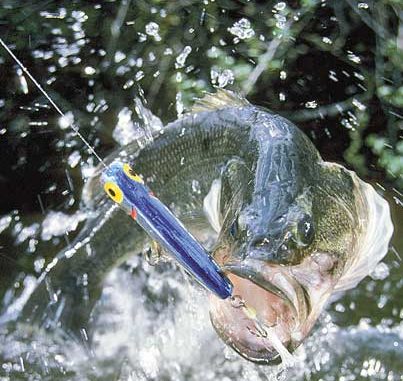
Most of the fishermen I know in South Carolina recognize that March is a great month to be on the water, and to really take advantage of the bass-fishing opportunities out there, they know they need to have a crankbait tied on.
But I doubt that all of them realize that one of the easiest crankbaits to fish is also one of the most productive: a lipless bait.
We know them by all kinds of different names, and the different makes and models usually have in common an oval-shaped profile, flat sides and some kind of hollow, rattle-filled body. For their size, they’re fairly heavy, they cast like rocks — and they really catch bass, especially in the early spring.
Fishermen typically think about lipless crankbaits later in the year, like when you’re chasing schooling fish during the summer, or in the fall when bass are really in tune and reacting to shad. But March is a great time to fish a lipless bait.
What really separates a lipless bait from a lot of other crankbaits is that it seems like you can fish it really fast and still catch fish when the weather’s cold. That’s one thing I’ve learned from Kevin Van Dam, one of my two roommates on the road. A lipless bait, even though the water is cold, you can fish it fast and catch bass, even when the water temperature is in the mid-40s when it’s tough to get a bite on anything else you can throw.
There are a variety of ways to fish a lipless bait like a Rat-L-Trap or a Yo-Zuri Rattlin’Vibe or the Strike King Red Eye Shad that I fish a lot. You can just cast it out and chunk and wind it back, or you can slow-roll it, or you can let it sink and jerk it up off the bottom.
The one thing you need to think most about is how deep you want to fish the bait. That will determine how heavy a bait you use and how you want to fish it.
If you chunk-and-wind it, you’re usually fishing it between one and four feet deep. If you want to fish shallow and you’re using a half-ounce bait, you probably need to be using a quarter-ounce bait that won’t sink as quickly. I like to slow-roll a Red Eye Shad to try and tick the tops of grass or any kind of cover I’m fishing, and that’s when a half-ounce bait can be really good.
Lipless baits get reaction strikes from bass. Obviously, when the water’s in the high 40s or low 50s, a bass isn’t going to have the energy to chase a bait, but if you can make a sudden movement with a bait right in front of a fish’s nose, you might get a bite.
Most of the time I fish a lipless bait, I’m trying to fish it around cover that might be holding bass, whether it’s grass or a brushpile or a shallow point with rocks or stumps. You want to bring it along and hit the cover and then pop the bait out of it and let it fall — that’s when you get the reaction bites.
How a bait falls when you drop it down and pop it out of cover, that’s a key. The exceptional thing about the Red Eye Shad that’s made by one of Kevin’s sponsors — I don’t have a sponsor for a lipless crankbait — is how it falls. A lot of times, when a lipless bait falls down through the water, it will roll over on its side and kind of spiral down. The Red Eye Shad falls just like you retrieve it, belly down, and that’s really important, because most of the fish you catch are when the bait comes off the cover and you let it fall.
When I tie on a lipless crankbait, I’ll usually fish it on a long rod, because I’m typically fishing it in open water where I need to make long casts to cover a lot of water. I fish them on a 7-foot, medium-action All-Star baitcasting rod with a Pfleuger Patriarch reel that has a 6.3-to-1 retrieve ratio. That’s a fast reel, and that’s great when you’re fishing a lipless bait.
I also like to fish a lipless bait on fluorocarbon line, usually 10- to 20-pound test. I know a lot of guys fish lipless baits on braided line, but I like the feel of fluorocarbon better. I normally use something like Trilene Gold Fluorocarbon. If you’d rather fish a lipless bait on braid like Spiderwire EZ Cast, one thing you need to do is switch out your hooks. Because you get almost no stretch with braid, you need to go to a heavier hook, something like the XX or XXX-strong hooks that Owner makes, instead of the light-wire hooks that come on most baits.
One last thing about lipless baits. Unlike other lipped crankbaits, you can match them to the size of the bait that bass are feeding on without having to change how deep the bait can run. At different times of year, even in different areas of the same lake, you might run into concentrations of baitfish that are bigger or smaller. You can mimic the size of the baitfish with your lipless bait. In the spring, if you find some little 1-inch shad, you’re going to want to fish a quarter-ounce bait. If you find bigger shad or herring, you’ll want a half- or ¾-ounce bait.


Be the first to comment